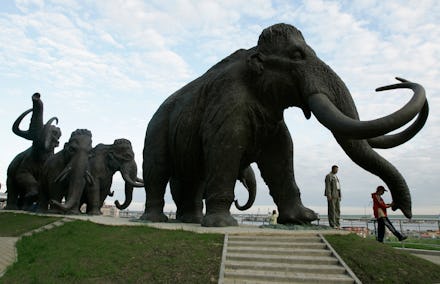Scientists Are One Step Closer to Cloning a Modern-Day Woolly Mammoth

In what's probably the closest thing to a real-life version of Jurassic Park, Harvard University research scientists have successfully spliced genes from a woolly mammoth with those of an Asian elephant, taking us one step closer to recreating the ancient beast in modern times.
To be clear, unlike Jurassic Park, this isn't cloning, according to research leader and Harvard genetics professor George Church. Instead, the team has rebuilt the genome on a cellular level in order to observe the DNA interacting with that of the Asian elephant, its closest living relative.
Because mammoths thousands of years old have been found frozen and preserved, the researchers were able to analyze the DNA of a permafrost-preserved specimen, a kind that lived in the Arctic until 3,300 years ago, as their basis for research.
"We prioritized genes associated with cold resistance, including hairiness, ear size, subcutaneous fat and especially hemoglobin [the blood molecule that carries oxygen around the body]," Church told the Sunday Times.
The background: The idea to clone woolly mammoths isn't new, nor does it come without ethical dilemmas. But scientists who have been tinkering with the idea see it as a means of not only learning more about the history of fauna on the planet but as a means of protecting that planet now.
"All the plant species survived on the backs of these animals," Hendrik Poinar, professor of evolutionary genetics at McMaster University, told CBS News. "If we brought the mammoth back to Siberia, maybe that would be good for the ecosystems that are changing because of climate change."
According to the Long Now Foundation, with which Church is doing his research, the goal is not to make exact replicas of mammoths, but figuring out how to hack the biology of Asian elephants to withstand the Russian tundra's brutal cold, able to assist in potentially revitalizing the Russian taiga. With Church's successful splicing, protecting that ecosystem could be closer than ever before.
The takeaway: So far, the woolly mammoth DNA is functioning normally in the cells of its living distant relative. The end goal is being able to implant an engineered mammoth embryo into a living Asian elephant, and, according to Church, that means the the first cloning attempt could be sometime during 2018.
At this point, there's more work to be done before they publish an official paper, and they're still a long way from being able to clone an actual woolly mammoth. But this is an early step in what could be used to learn more about the colossal animals that walked the earth with the earliest humans. Which would be great, just so long as they take it easy when it comes to researching velociraptors.